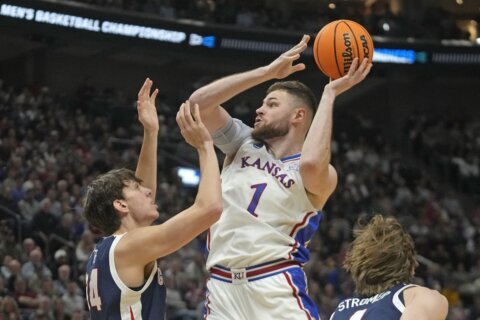CLEVELAND (AP) — Long before Caitlin Clark broke records, packed arenas across the country like a Taylor Swift in sneakers and inspired young girls to be like her, women’s basketball looked very different than it does today.
Until 1997, there was no WNBA. Media coverage was minimal. The madness of March was almost exclusively the men’s domain.
Born five years following the WNBA’s launch, Clark has never known anything but what she’s helped create — a spectacular game underscored by a record 12.3 million viewers watching Monday’s LSU-Iowa rematch in the NCAA Tournament — and a sport with room to grow.
While Clark has done her part with every step-back logo 3-pointer, a generation of women cleared the way.
And as the Final Four roars into Cleveland this week —- Clark is there after scoring 41 in the regional final to dethrone Angel Reese and the defending champion Tigers — those roundball revolutionaries are getting a long overdue salute.
More than 40 years later, Nancy Lieberman remembers Billie Jean King assuring her she was blazing trails.
“She told me when I was 22, ‘You’re a pioneer,’” said Lieberman, whose on-court wizardry earned her the nickname “Lady Magic” and made her a three-time Kodak All-American at Old Dominion, two-time Olympian and Naismith Hall of Famer.
“I’m like, what? I’m a pioneer? I didn’t know what she meant. I know what she means now.”
It’s easy to forget that the 1996 U.S. Olympic team, which jumpstarted two professional leagues, played in 5,000-seat arenas during the Atlanta Games. And before those leagues launched, women went overseas to play professionally.
As Clark rewrote the record books this season while pushing TV viewership to unimaginable levels and pulling unprecedented attention to the women’s game, she steered the spotlight toward stars who preceded her. With the same deft touch as one of her down-court passes for an assist to a fast-breaking teammate, Clark has connected present to past.
Before dynasties at South Carolina, UConn, Tennessee or Louisana Tech, there were dominant programs at Delta State and Immaculata University, the first women’s national champions in 1972.
Clark’s run has also illuminated the contributions of some of the sport’s giants — greats like Lieberman, Ann Meyers Drysdale, Pearl Moore, Carol Blazejowski, Cheryl Miller, Maya Moore, Lynette Woodard and many others who laid the foundation for the heights the game has reached in 2024.
These women, some of whom have records that still aren’t acknowledged by the NCAA, have been glossed over in these Tik-Tok times.
“Those are the forgotten names, and they’re only brought up because there’s a record that was being broken where we haven’t done a great job at historically producing documentaries on the history of women’s basketball,” said South Carolina coach Dawn Staley, who has her undefeated team in a fourth straight Final Four.
“We have to do a better job,” Staley added. “This day and age will be documented and told a million times, and I hope when that’s being told that we pull from the legends. We’re standing on their shoulders, and what they’ve done should not be forgotten.”
Maybe not household names like today’s top players, who have benefitted from increased media attention the past two decades, and when NIL didn’t mean name, image and likeness but literally what they received for playing, they are the ones who made everything possible.
Barrier busters and then some.
“Some people play the game, and some people change the game,” Lieberman said in a phone interview. “I changed the game. Caitlin has changed the game. Cheryl Miller changed the game. Diana Taurasi changed the game. Brittney Griner changed the game and that doesn’t mean you’re not a hell of a player.
“There’s a lot of really good players, but how many have really changed the game?”
And my, how the game has changed.
Since 1972 and Title IX’s historic passing, which at least in theory gave females the same athletic opportunities as their male counterparts, women’s basketball has grown from a gym class activity in some places to a global game.
Professional leagues with varying degrees of success started and folded before the WNBA, which has blossomed in popularity with players and teams proudly promoting social activism and inclusion — along with playing high-level hoops.
For Meyers Drysdale, it’s been like watching a child learn how to crawl, walk and run.
It’s hard to imagine, but it wasn’t that long ago when women didn’t receive athletic scholarships. In fact, Meyers Drysdale, who had a highly publicized NBA tryout 45 years ago, was the first to get four-year financial assistance.
She followed her All-American brother, Dave, and played at UCLA, a decision she made casually at a family cookout.
“David was teammates with Kenny Washington and Kenny was going to be the women’s coach,” Meyers Drysdale said. “They came home for a weekend and said, ‘How would you like to go to UCLA and play basketball?’ I said, OK. That was the extent of my recruitment.”
That memory draws a hearty laugh from Meyers Drysdale, who was Clark and LSU’s Angel Reese rolled into one.
One of 11 children, she was one of one on the court — or anywhere she competed.
Along with basketball, Meyers Drysdale played softball, badminton, field hockey, tennis and ran track. So gifted, she won the female version of ABC’s “The Superstars” and competed in the men’s event. During filming she met her husband, Don, a Hall of Fame pitcher with the Dodgers who died of a heart attack in 1993.
Her flirtation with the men’s pro game came in 1979, when Meyers Drysdale made history as the first female to get an NBA tryout after signing a $50,000 free agent contract with Indiana.
She held her own before being cut by the Pacers after six practices, but her foray on the floor with men was a pivotal moment of acceptance for women. Doors were beginning to open.
“I got a lot of publicity with my tryout,” she said. “It helped. We didn’t have podcasts. We didn’t have social media. We had the local TV stations. We had local newspapers. You didn’t have all the stuff they have today.”
Lieberman and Meyers Drysdale don’t begrudge the modern player. Just the opposite. They lit the torch and proudly passed it along.
When they were young, there were no professional star to inspire them, no chartered planes for road trips, no state-of-the-art facilities on college campuses — not even basic equipment.
The late Pat Summitt — who made a meager $250 a month when she started at Tennessee — had to fight for athletic apparel like sports bras.
“We didn’t have trainers or anyone to tape our ankles,” said Meyers Drysdale, vice president of the Phoenix Mercury. “We didn’t have practice uniforms. You’d wear the same uniform two or three years in a row.”
For Lieberman, the soaring state of women’s basketball is a testament to her generation and a new one pushing it higher.
In recent years, the 65-year-old has bonded with Clark, and Lieberman finally got to see her play in person last week when she attended the superstar’s home finale in Iowa City. When it ended, Clark presented Lieberman with one of her game-worn jerseys.
“The greatest thing that has happened to women’s basketball for the next level of growth is Caitlin Clark, Angel Reese and some of those kiddos,” Lieberman said. “But in particular what this woman has done. She kind of did this.”
Some pioneers helped.
___
AP March Madness bracket: https://apnews.com/hub/ncaa-womens-bracket/ and coverage: https://apnews.com/hub/march-madness
Copyright © 2024 The Associated Press. All rights reserved. This material may not be published, broadcast, written or redistributed.






